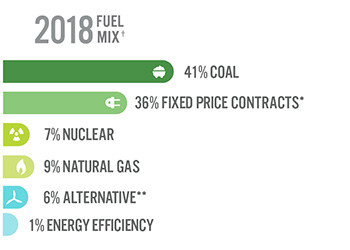 The electricity powering your home has been created by a variety of different resources — all part of a plan to ensure you have more stable rates.
The electricity powering your home has been created by a variety of different resources — all part of a plan to ensure you have more stable rates.
Wabash Valley Power (WVPA) creates the electricity that Kankakee Valley REMC delivers to your home from a variety of generation resources that include coal, natural gas, and sustainable resources such as: solar, wind, nuclear, hydro, and landfill gas.** WVPA receives 41 percent of its electricity produced from coal, which is 16 percentage points lower than 2017.
“By having a variety of resources, we make sure that the WVPA co-ops’ members are safeguarded from unexpected market turbulence,” said Lee Wilmes, executive vice president of risk and resource portfolio for Wabash Valley Power. “As technology progresses, additional resources become more affordable to the point that it makes sense to add some of those resources in our portfolio.”
Earlier this year, WVPA announced that it will purchase the 198 megawatts (MW) of electricity that will be produced by two Illinois solar facilities to be built and operated by Ranger Power, a utility-scale solar development company. The arrays collectively will produce enough electricity to power nearly 30,000 homes.
“As a cooperative, we strive to enter into agreements that have a positive impact for everyone involved, particularly in the communities that we serve,” Wilmes said. “Our agreement with Ranger Power is in keeping with our commitment to provide sustainable energy resources for our members.”
Wabash Valley Power continuously plans for the future and seeks new opportunities with a keen interest on what makes most sense for all people served by its member co-ops, including Kankakee Valley REMC.
** Wabash Valley Power supports renewable energy by owning landfill gas generation and purchasing the output of wind farms and biogas generators. Wabash Valley Power sells, separately, the environmental attributes associated with this generation to its members and third parties, and therefore does not claim the generation as renewable within its own supply portfolio.



